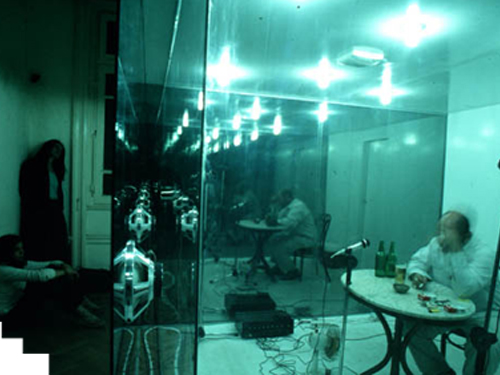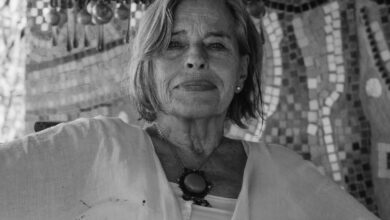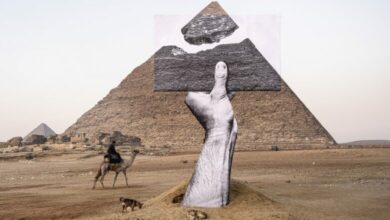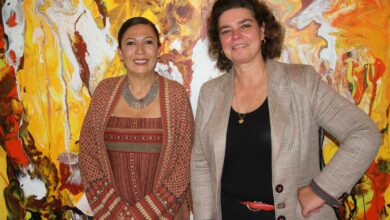
LONDON – For 14 nights, Hassan Khan and Nida Ghouse sit down in conversation to explore the back catalogue, artistic past and present, and distant memories of musician, writer and artist Hassan Khan. In the intimate setting of the Delfina Foundation in London, this conversation that began a year ago is continuing between artist and curator, with a small select audience invited to join and encouraged to contribute over a period of two weeks.
Titled “14 Proper Nouns,” it is based around 14 references taken from Khan’s 2003 piece “17 and in AUC” in which he sat for four hours every night for two weeks in a sound-proof booth constructed in a rented downtown Cairo apartment, where he could neither see nor hear his audience (but they could of course both see and hear him), drinking, smoking and talking about his teenage years in the early 90s, when he studied at the American University in Cairo.
The transcript was made into a book, described by Ghouse as “a finite repository of memory” and “an endless stream” as it flows without commas or full stops so as to read as a single uninterrupted train of thought. It includes over 500 proper nouns and from these, Ghouse and Khan have chosen 14 that are relevant and meaningful, both then and today, to act as a launch pad to explore the roots of Khan’s practice.
Khan has never read the transcript, but he begins each discussion reading aloud a passage that includes that night’s noun, and from there, as Ghouse puts it, tries “to make sense of the blur of the past”.
Quite fitting for an artist who is loath to be categorised, labelled or put in any sort of box, it is very difficult to explain or grasp what this project is about, what its aims are or where it will go next. Indeed both Khan and Ghouse are hard to pin down on this, viewing it as one stage of an ongoing process – hinting that it could develop into a book or an exhibition, or maybe something completely different. The fluid and organic way in which it is structured means that it is really only through attending and participating that one can draw out a sense of the process as it unfolds.
It is best described as a public piece of research: a curator’s fascination with and investigation into the work of an artist; an experiment in the interactions between artist and curator; and a very personal journey for the artist himself into his own past as he discovers long-forgotten fragments of works that were never shown, and would never have been shown, alongside the roots of some of his most acclaimed pieces.
This unusual and innovative approach lays bare the tangled threads of Khan’s body of work, which is diverse and resistant to definition, and probes how he has arrived at different points in his practice. This is a process that is “very risky” for Khan.
“I expose things I would not expose, or works that I would not show because they’re not works as such – they’re very early or they’re experiments, but they’re relevant to the discussion so they need to be shown,” Khan explains.
The public format not only allows audiences a rare insight into Khan’s development and early work, but it is also an important tool for the project. “It brings a certain pressure to the discussion that I think enhances it and forces us to find a focus to develop it – it’s a way of propelling the research further,” Khan tells Al-Masry Al-Youm, adding: “It also forces the research to go through the public which pushes us, and maybe Ghouse more, to discover how talking about these things can be relevant in a larger scope.”
The references themselves constitute sort of non-categories that act as a point of departure for each discussion. “Funhouse” was the title for the first night, and is what Khan called the apartment he lived in with his friend Amr and two others in his last year of AUC – a good starting point for this excavation of his work. He showed a piece called “Lung Fan” which, despite receiving “an incredibly negative response” at the time, is a significant piece to the evolution of his practice. He sees it as his first “proper work” and was the product of the “telepathic” relationship between him and Amr -his music with Amr’s photography – and their experience living in this house “which existed to parallel everything.”
While this discussion tapped into a certain period of his early life, not all the references were so clearly tied to an exact point in time. Some centred on figures that had influenced him: from “Hendrix,” and his awareness and deconstruction of his musical medium, to “Yassin El-Tohami”, the munshid (chanter) who has had a profound influence on Khan both personally and in terms of his practice, in particular his work with shaabi music.
Others were more abstract, such as “Midan Ramsis” (Ramses Square) through which he explored the nature and characteristics of “the crowd” and how he has treated this as a theme. Thus it is through this series of references whose meaning and significance comes into focus through each night’s discussion that “14 Proper Nouns” is structured.
It is unclear where these discussions will lead, but they in themselves present an alternative history or narrative, one that, as Khan puts it, “touches certain moments in the art and intellectual history of a place through the prism of one’s practice.” And thus, while on one level this project is very narrow, delving into the work of a single artist, it also taps into a broader context – capturing an array of themes and influences that have impacted the varied and unruly collective work of this artist.
14 Proper Nouns runs until 3 November at the Delfina Foundation in London. 29 Catherine Place, London SW1E 6DY, UK




